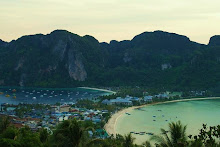What will you do if you breathe but no oxygen is inhaled? Scary huh. I felt that moment, when I was reaching 4,000m high at the basecamp to Langtang Glacier. That night I could not sleep, symptom of a high altitude sickness. I got no appetite either. And somewhat vomitting.
Until over midnight, when silence was the only presence, I could finally close my eyes but not for that long. I was pretty scared, honestly. I got to be accustomed to breathe with only one third oxygen intake into my lungs.
Theoretically, I have to climb higher, say 4,500 m first then go down at least 500 m to the altitude of 4,000 m for overnight stay and acclimatising. But this time, there's no time to climb higher, the weather and time just did not favorable to do that. The result was, whenever I reached the 4,000 m basecamp, I had to stop the trek and stayed overnight. My lungs were not yet adapting to this new environment and demanding more oxygen, which was not available!
Fortunately, I could manage the acclimatising process within a few hours. I shortened my heart beats and totaly did relaxing all my bodies to save the oxygen. A few hours later, my body could finally adapt to this new altitude and I could feel my blood circulating as normal. No more headache and vomitting.
In the morning, I was okay. The same story applies to the extreme cold acclimatising process. Spending the rest of my life in the equator weather of 30-35C, I had to push myself to the limit dealing with sub zero temperature, which once reached -16C. How's that feel? It's damn cold! Twice as much colder than your freezer box. But I survived. How?

I learned that it is not the extreme temperature that makes you cold, but your body itself. When you get into an extreme cold environment, one thing to note is to prevent your body heat leaking outside, meaning that you have to keep your body warmth inside your inner clothing. That's why you need thermal clothes. A material that could retain heat and prevent it from evaporating. At once it should be able to 'breathe' your sweat.
No matter how cold it may be, when we are climbing, as our calories are burnt, we produce heat and sweat. Good thermal clothes will retain the heat but releasing the sweat for evaporation, it keeps your body dry. If sweat cannot be released, it could turn to be very cold and absorb your body heat. A fatal mistake.
Amazingly, our body is a supermachine. It can adapt very quickly to the environment. Its versatility provides you with comfort out of an extreme temperature. When I reached 3,500m in a mid-day, the temperature was nearly zero because of the breeze from the surrounding ice mountains. I put on my cloves and thermal cap, and down jacket for sure. However after a few hours, under the same temperature, I could simply wear light jacket without cloves and cap. I was then feel comfortable with that cold.
It happened when I went higher and higher. I believe that's why they suggest acclimatising one night every 1,000m above 3,000m altitude, to let your body find its pattern adapting the extreme environment.
What an experience! Thanks Himalaya.






